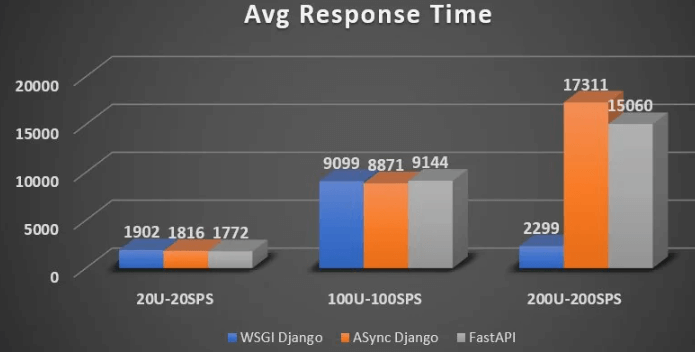Django vs FastAPI: Which Python Framework to Choose for a Web Application?

Choosing the right framework for Python web development is key to the successful implementation of the project. Python has a number of frameworks for web applications: Django, Flask, FastAPI, Pyramid, Bottle, CherryPy, etc. among which Django and FastAPI are especially popular. If you are interested in custom Django development, understanding the differences between Django and FastAPI will help you choose the tool that best suits the specifics and needs of the project. In this article, we offer to evaluate these differences.
Django
Currently, Django is one of the most popular Python frameworks. It is an open-source development environment created in 2003. This framework comes with many tools that developers need, such as an ORM structure, an admin panel, a directory structure, and more.
Django is based on the DRY principle. Thanks to this, the code is not repeated within the project, which makes it easy to read for other developers.
The framework is often used for large applications. For example, Google Search, YouTube, Reddit, Pinterest, Spotify, and Dropbox are written in it.
Benefits of Using Django
There is a reason why the tool is popular among businesses and developers. Let’s look at some of its advantages and features:
- Security.
Django pays special attention to security, providing protection against common SQL injections, cross-site scripting (XSS) and cross-site request forgery (CSRF).
- Good scalability.
The framework can handle any functional and hardware solutions. In addition, it can withstand heavy traffic. This is the main reason why huge corporations like Google use it.
- A large set of libraries and modules.
Thanks to good community support, Django regularly gets new libraries and plugins that simplify the development process.
Disadvantages of Django
Although the framework is known for its capabilities, it still has several disadvantages:
- Not suitable for simple projects
- Does not support multiple requests
- To work, you need to know the entire system
Django Use Cases
The framework can handle projects of any size and power. But it is best suited for high-performance web applications with high traffic. Here are some of the use cases:
- Trading platforms;
- News sites;
- Scientific and financial platforms;
- Social networks;
- Administrative panels.
FastAPI
FastAPI is a relatively new web development framework that is only compatible with Python 3.6+. It can be called a microframework, as its built-in capabilities are not that extensive.
FastAPI is one of the most popular Python frameworks for creating REST services. It compensates for a number of shortcomings of other tools. FastAPI is easy to use and learn, easy to deploy, and also gives the developer the advantage of asynchronous request processing.
Benefits of Using FastAPI
Among the main benefits of using FastAPI:
- Performance.
FastAPI focuses on speed. The framework works faster compared to other Python platforms. In a number of benchmarks, it showed better results than Django or Flask.
At the same time, FastAPI wins not only in the number of processed requests per second but also in the speed and ease of development. A developer can deploy a project with just 5 lines of code.
- Built-in data validation.
Built-in data validation allows developers to write more compact code by skipping additional checks. It detects incorrect data types even in deeply nested requests and returns a justification in JSON format. According to the authors of FastAPI, this reduces the number of developer errors by 40%.
- Asynchronous code support.
The special feature of FastAPI is that it supports asynchronous code out of the box. This feature was added to Python only in version 3.4, so FastAPI does not work with earlier versions. With asynchronous code, requests are executed independently of each other and can be run in parallel, meaning that execution time is significantly reduced compared to sequential execution.
- Built-in API documentation.
FastAPI offers an extremely convenient automatic documentation system. It provides a browser-based UI that interactively documents the API based on the Swagger UI graphical user interface.
Additionally, developers can easily get alternative documentation that contains all the listed endpoints. Documentation always allows developers to easily explain the program to others, makes it easier for front-end developers to use the backend, and simplifies testing the API endpoints.
Disadvantages of FastAPI
Of course, FastAPI is not without some disadvantages:
- Lack of built-in security system
- Small developer community
Read also Comprehensive Gutter Cleaning Services by SJ Contractor Services in Woodbridge VA and Nearby Areas
Differences Between Django And FastAPI
Django is a mega-framework that includes a large number of features in its boxed version, while FastAPI is a micro-framework that focuses on ease of use and performance.
Let’s look at the main differences between these 2 development tools:
- Popularity.
Here, Django is definitely the favorite, as it is older and larger. Moreover, if you compare by the number of stars on Github, the difference is not that significant: 80.8 thousand stars against 77.4 thousand.
This means that the community likes the capabilities of the new tool, and it is actively used in projects. This means that in the future, the place of the main framework for Python may go to another candidate.
- Difficulty of learning.
Both frameworks can be called quite easy to learn. Python often becomes the first programming language for developers due to the low entry threshold.
But since Django is used in large-scale projects, as the size and complexity of the application increases, competent developers will be required. The learning curve is quite steep, which means that competent professionals in this field will be quite difficult to find.
- Flexibility.
FastAPI does not limit the developer to certain rules, so it gives a sense of freedom when writing code. But Django works differently: it provides a coding standard and expects everything to be done in a certain way.
- Security.
Django offers users good opportunities to support product security. This allows you to avoid common cyber attacks such as SQL injection attacks, etc. FastAPI also has several plug-in tools for security issues. But still, Django is considered more secure.
- REST API Development.
FastAPI is suitable for REST API development. Django does not support REST API by default, there is a special DRF library for this.
Final Thoughts
The choice between Django and FastAPI largely depends on the type of project, its scalability, and the expected load. Django is ideal for creating powerful web applications where built-in administration and authentication functions are important. FastAPI, on the contrary, focuses on speed and asynchronous requests, which makes it the optimal choice for API-oriented applications. If you are interested in customized Django development, we recommend paying attention to the SECL Group company, which also offers a number of other services for the development of various IT products and data management.




